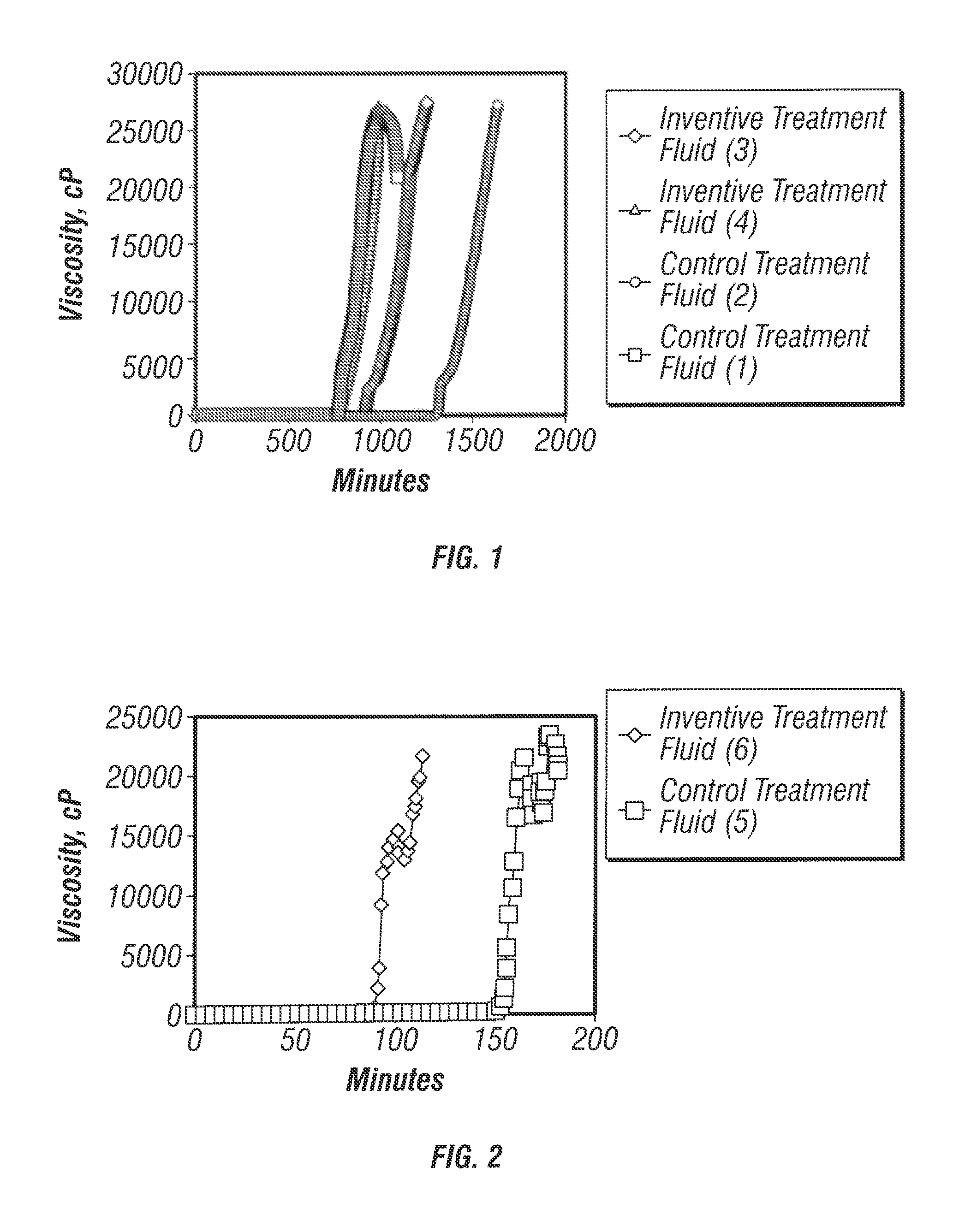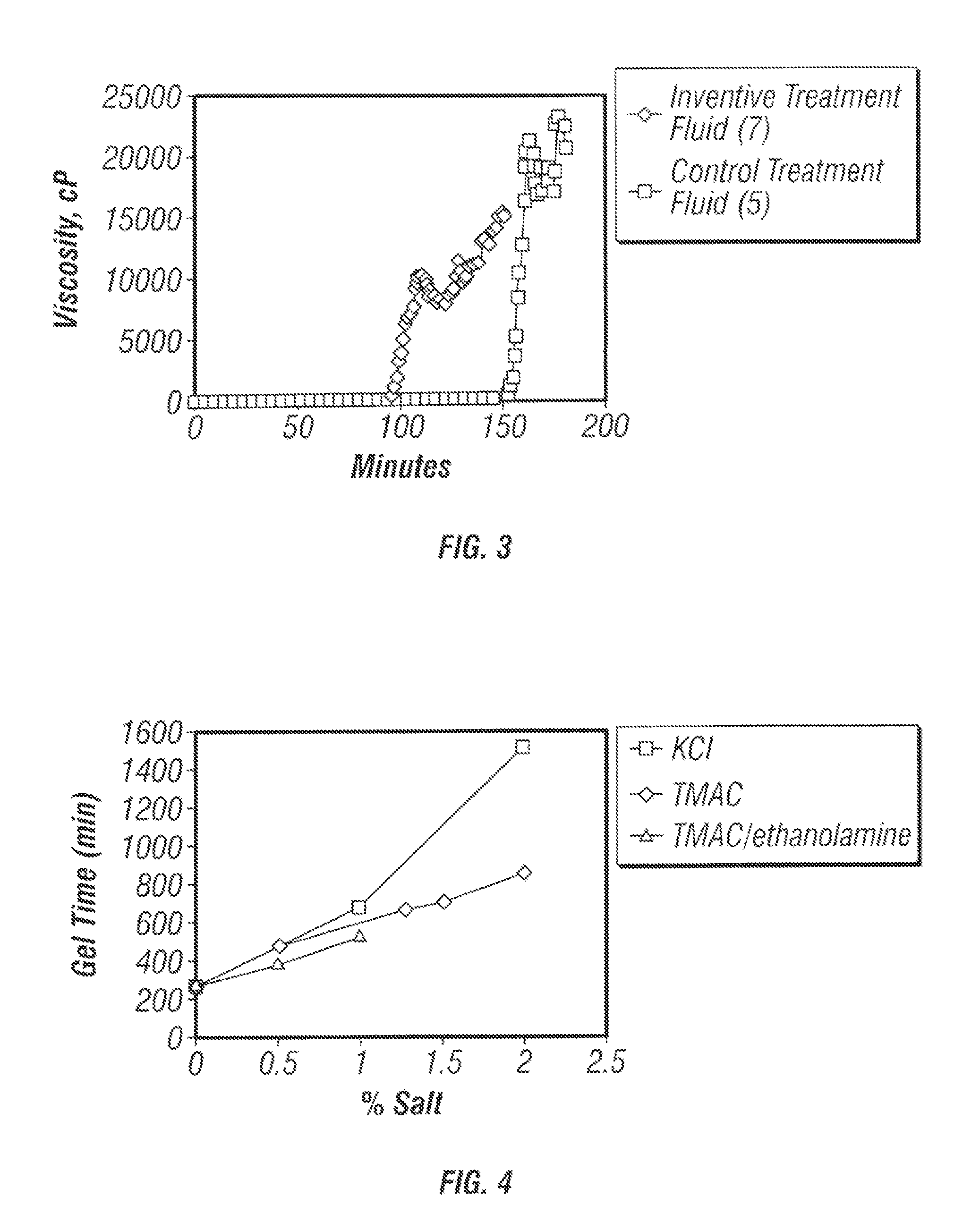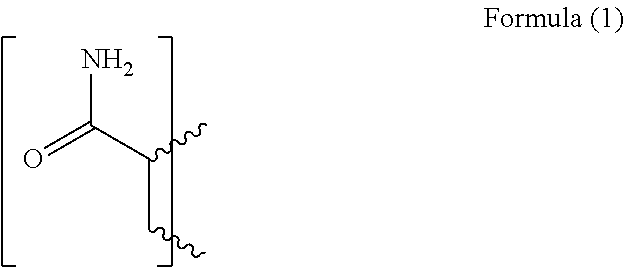Gellable treatment fluids comprising quaternary ammonium salt gel-time modifiers and methods for use thereof
a technology of gel-time modifiers and treatment fluids, which is applied in fluid removal, borehole/well accessories, chemistry apparatus and processes, etc., can solve the problems of increasing the cost of separating water and disposing of it, affecting the production of hydrocarbons, and often accompanies water undesirably, so as to reduce the gel-time
- Summary
- Abstract
- Description
- Claims
- Application Information
AI Technical Summary
Benefits of technology
Problems solved by technology
Method used
Image
Examples
example 1
Gel-Times in Gellable Treatment Fluids Comprising a t-Butylacrylate / Acrylamide Base Polymer and Polyethyleneimine
[0052]Control gellable treatment fluids were prepared at the following compositions: (1) 350 gal / Mgal “HZ-10” and 30 gal / Mgal “HZ-20” in a 2% aqueous KCl base fluid, and (2) 175 gal / Mgal “HZ-10” and 30 gal / Mgal (“HZ-20” in a 2% aqueous KCl base fluid. Inventive treatment fluids were prepared at the following compositions: (3) 175 gal / Mgal “HZ-10” and 30 gal / Mgal “HZ-20” in 2% aqueous tetramethylammonium chloride, and (4) 175 gal / Mgal “HZ-10” and 30 gal / Mgal “HZ-20” in 2% aqueous tetramethylammonium chloride also comprising 0.5% ethanolamine. “HZ-10” is a t-butylacrylate / acrylamide copolymer that is available from Halliburton Energy Services of Duncan, Okla. “HZ-20” is a polyethyleneimine polymer that is available from Halliburton Energy Services of Duncan, Okla. The source of tetramethylammonium chloride was “CLAY FIX II”), which is available from Halliburton Energy Servi...
example 2
Gel-Times in Gellable Treatment Fluids Comprising a Partially Hydrolyzed Polyacrylamide Base Polymer and Polyethyleneimine
[0054]A Control gellable treatment fluid was prepared at the following composition: (5) 175 gal / Mgal “FDP-835™” and 30 gal / Mgal “HZ-20™” in a 2% aqueous KCl base fluid. Inventive treatment fluids were prepared at the following compositions: (6) 175 gal / Mgal “FDP-835™” and 30 gal / Mgal “HZ-20™” in 2% aqueous tetramethylammonium chloride, and (7) 175 gal / Mgal “FDP-835™” and 15 gal / Mgal “HZ-20™” in 2% aqueous tetramethylammonium chloride. “FDP-835™” is a partially hydrolyzed polyacrylamide that is available from Halliburton Energy Services of Duncan, Okla. The source of tetramethylammonium chloride was “CLAY FIX II™.”
[0055]The viscosities of the above treatment fluids were measured as a function of time in order to determine their gel-times. Viscosity measurements were made at 160° F. FIGS. 2 and 3 show illustrative plots of viscosity as a function of time for variou...
example 3
Comparison of Gel-Time Modification Ability of Inorganic Salts, Tetraalkylammonium Salts and Amine-Containing Compounds in Gellable Treatment Fluids Comprising a t-Butylacrylate / Acrylamide Base Polymer and Polyethyleneimine
[0056]A gellable treatment fluid comprising 175 gal / Mgal “HZ-10™”, and 30 gal / Mgal “HZ-20™” was prepared and differing amounts of KCl, tetramethylammonium chloride, and tetramethylammonium chloride comprising a fixed amount (0.82%) of ethanolamine were separately added. The gel times were measured at 160° F. FIG. 4 shows an illustrative plot comparing the gel-times of gellable treatment fluids comprising KCl, tetramethylammonium chloride and tetramethylammonium chloride / ethanolamine as a function of concentration. FIG. 4 shows the following results: 1) For a given weight percent of salt, tetramethylammonium chloride provided a shorter gel-time compared to the same amount of KCl. 2) Increased amounts of tetramethylammonium chloride increased the gel-time, although ...
PUM
| Property | Measurement | Unit |
|---|---|---|
| temperatures | aaaaa | aaaaa |
| temperature | aaaaa | aaaaa |
| temperature | aaaaa | aaaaa |
Abstract
Description
Claims
Application Information
 Login to View More
Login to View More - R&D
- Intellectual Property
- Life Sciences
- Materials
- Tech Scout
- Unparalleled Data Quality
- Higher Quality Content
- 60% Fewer Hallucinations
Browse by: Latest US Patents, China's latest patents, Technical Efficacy Thesaurus, Application Domain, Technology Topic, Popular Technical Reports.
© 2025 PatSnap. All rights reserved.Legal|Privacy policy|Modern Slavery Act Transparency Statement|Sitemap|About US| Contact US: help@patsnap.com



